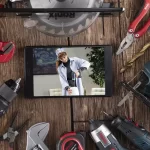The roar of an engine fades. In its place, a silent symphony of torque propels you through the dirt, your only soundtrack the crunch of tires and the wind in your hair. Welcome to the electrifying world of DIY electric dirt bike conversions, where gasoline gives way to green grins and adrenaline still pumps with every jump.
But transforming your trusty gas-guzzler into a silent shredder isn’t a stroll in the park. It’s a journey of grit, grease, and ingenuity, a baptism by wrench that rewards you with an eco-friendly beast of your own making.
Why DIY?
The reasons are as varied as the riders themselves. Some crave the satisfaction of crafting their own machine, customizing every bolt and wire to their specs. Others seek the thrill of pioneering the future of off-road, leaving behind the fumes and noise for a cleaner, quieter way to ride. And for some, it’s simply a matter of affordability – converting an existing bike can be significantly cheaper than buying a brand-new electric dirt bike.
The Electrifying Toolbox:
So, you’ve caught the DIY bug? Here’s what you’ll need:
- Mechanical know-how: This ain’t Lego, folks. You’ll need basic mechanical skills and the ability to follow complex instructions.
- The donor bike: Choose a sturdy dirt bike you’re comfortable working on. A lightweight frame and good suspension are ideal.
- Conversion kit: These kits typically include the electric motor, controller, battery, wiring harness, and other essential components. Research various options based on your budget and power needs.
- Tools and workspace: Welders, wrenches, soldering irons, and a dedicated space to get messy are your new best friends.
The Journey Begins:
Building an electric dirt bike is not just about swapping parts; it’s a blend of art and science. Before diving in, understand that a solid grasp of electrical engineering, mechanics, and fabrication will be your best allies on this journey.
The Essentials:
Your adventure starts with gathering key components. Here’s what you’ll need:
- Electric Motor: The heart of your bike.
- Lithium-Ion Battery Pack: Your power source, ensuring you have the range and reliability.
- Motor Controller: The brain that manages your motor’s performance.
- Throttle System: Your direct connection to speed and control.
- Charger: To keep your battery ready for action.
The Process:
The conversion process varies greatly depending on your chosen kit and bike, but the general steps involve:
- Stripping it down: Say goodbye to the engine, exhaust, and fuel system. Embrace the lightness of bare bones.
- Mounting the motor: Find a secure and balanced location for your electric heart. This might involve fabrication or modifications.
- Wiring the beast: This is where your patience and soldering skills come into play. Follow the kit instructions meticulously. Ensure that the motor and battery pack are connected to the controller with wiring capable of handling high current flow. This is crucial for maintaining efficiency and safety, preventing any potential overheating issues.
- Battery power: Mount and secure your battery, ensuring easy access for charging and a proper voltage connection to the controller. Double-check that all connections are tight and insulated to avoid any electrical shorts or leaks. This attention to detail will keep your ride smooth and reliable.
- Test and tweak: This is where your creation comes alive! Start with low power and gradually ramp up, making adjustments as needed for optimal performance and safety.
Frame and Mounting:
Choose a dirt bike frame that is compatible with your new components. You may need to design a custom mounting system to secure everything in place. This ensures your bike maintains its structural integrity and performance.
Safety First:
Always wear appropriate safety gear and ride responsibly. If you’re unsure about any step, consulting with a professional can provide invaluable guidance and assurance.
By following these steps, you’re well on your way to transforming your vision into reality. Remember, patience and precision are key, and the thrill of the ride is worth every moment spent in the workshop!
Ideal Placement for Electric Dirt Bike Throttle
When setting up a throttle for your electric dirt bike, it’s crucial to choose the right location to enhance control and comfort. Here are key considerations to guide your installation:
- Handlebar Accessibility: Position the throttle on the handlebar in a place where it is easily reachable. Typically, this is on the right side, aligning with standard throttle configurations. This allows for intuitive use and ensures that adjustments can be made quickly while riding.
- Rider Comfort and Ergonomics: Ensure that the throttle placement suits the rider’s hand size and grip, allowing for easy manipulation without straining the wrist. A comfortable grip enhances control and reduces fatigue during longer rides.
- Clearance and Safety: Choose a location that avoids interference with other controls such as brakes or switches. This prevents accidental engagement and ensures that all controls can be operated smoothly without obstruction.
- Consistency with Design: Align the throttle setup with the overall design of the bike, ensuring that cables and wires are neatly routed. This not only maintains aesthetic appeal but also reduces the risk of damage or wear over time.
- Manufacturer Guidelines: Always consider specific recommendations from the bike or throttle manufacturer, like those from Shimano or Magura, as they might provide optimal installation instructions tailored to their product’s design.
By following these guidelines, you ensure that the throttle is not only conveniently placed but also enhances the overall riding experience.
Beyond the Bolts:
Remember, a DIY electric dirt bike isn’t just about parts. It’s about pushing boundaries, learning new skills, and becoming one with your machine. Be prepared for challenges, unexpected twists, and moments of utter frustration. But the satisfaction of conquering those hurdles and finally unleashing your electric beast onto the trails is a feeling like no other.
The Road Ahead:
The DIY electric dirt bike scene is a vibrant community of innovators, tinkerers, and passionate riders. Share your progress, troubleshoot challenges, and learn from others through online forums and groups. As technology advances and conversion kits become more user-friendly, the path to your own silent shredder is becoming smoother every day.
So, if the call of the wild and the hum of electric power whispers in your ear, grab your tools, channel your inner mad scientist, and embark on the thrilling journey of building your own electric dirt bike. The future of off-road is quiet, and it’s built in your garage.
FAQ:
How much does it cost to convert a gas bike to electric?
Costs can vary significantly depending on the chosen kit, bike, additional parts, and tools needed. Budget somewhere between $2,000 and $5,000 as a starting point.
2. What skills do I need for DIY conversion?
Basic mechanical skills and familiarity with wiring are essential. Comfort with welding and fabrication can be helpful. Remember, safety is paramount, so don’t hesitate to seek help if needed.
3. Which bikes are best for conversion?
Lightweight frames and good suspension are ideal. Popular choices include smaller dirt bikes like KTM Freerides or Honda XRs. Consider how easily the engine and fuel system can be removed.
4. Where can I find conversion kits?
Several companies offer electric dirt bike conversion kits online. Research their specs, compatibility with your chosen bike, and customer reviews before buying.
5. How long does the conversion process take?
Expect weeks, not days. Allow ample time for research, kit ordering, delivery, and the actual conversion work. Don’t rush the process and prioritize safety at every step.
6. What’s the range of a DIY electric dirt bike?
Range depends on battery capacity and your riding style. Expect around 20-40 miles on average, with options for upgrading batteries. Plan your rides accordingly and consider carrying a spare.
7. Are there any legal issues with riding a DIY electric dirt bike?
Regulations vary by location. Check your local laws to ensure your converted bike meets safety and registration requirements.
8. How can I find help and support during the conversion process?
Online forums and communities dedicated to DIY electric dirt bikes are invaluable resources. Share your questions, challenges, and successes with other builders and learn from their experiences.
9. Are there any safety concerns with DIY electric bikes?
High voltage involves danger. Follow kit instructions precisely, prioritize proper wiring and insulation, and never compromise safety during the conversion or while riding.
To ensure comprehensive safety, remember these key points:
- Wear Proper Safety Gear: Equip yourself with helmets, gloves, and protective clothing to shield against potential accidents or mishaps.
- Ride Responsibly: Exercise caution and control, especially when testing your electric dirt bike for the first time. Responsible riding is crucial for your safety and the safety of others.
- Consult a Professional: If you’re new to building or converting bikes, seeking guidance from a professional can be invaluable. They can offer insights that prevent costly and dangerous mistakes.
By combining precise technical adherence with personal safety measures and expert advice, you can enjoy your electric dirt bike with confidence and peace of mind.
10. Is it worth the effort to convert a gas bike to electric?
It depends on your budget, skills, and goals. It’s a challenging yet rewarding project, offering cost savings, environmental benefits, and the satisfaction of building your own unique machine. Weigh the pros and cons carefully before diving in.
Dust off your dreams, roll up your sleeves, and get ready to ride into the electric horizon!
Let’s keep the conversation rolling! Share your DIY electric dirt bike experiences and questions in the comments below!


